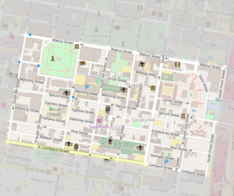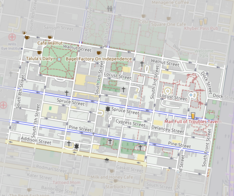This is an old revision of this page, as edited by JJMC89 bot III (talk | contribs) at 23:00, 24 February 2024 (Moving Category:Walnut Street to Category:Walnut Street (Philadelphia) per Misplaced Pages:Categories for discussion/Log/2024 February 16#Philadelphia street categories). The present address (URL) is a permanent link to this revision, which may differ significantly from the current revision.
Revision as of 23:00, 24 February 2024 by JJMC89 bot III (talk | contribs) (Moving Category:Walnut Street to Category:Walnut Street (Philadelphia) per Misplaced Pages:Categories for discussion/Log/2024 February 16#Philadelphia street categories)(diff) ← Previous revision | Latest revision (diff) | Newer revision → (diff) This article is about the Philadelphia neighborhood. For other uses, see Society Hill (disambiguation). United States historic place| Society Hill Historic District | |
| U.S. National Register of Historic Places | |
| U.S. Historic district | |
| Philadelphia Register of Historic Places | |
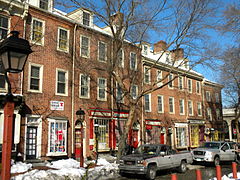 Head House Square on the 400 block of S. 2nd Street Head House Square on the 400 block of S. 2nd Street Map of Center City Philadelphia with Society Hill outlined in red Map of Center City Philadelphia with Society Hill outlined in red | |
   | |
| Location | Center City, bounded by 8th, Front, Walnut, and Lombard Streets |
|---|---|
| Coordinates | 39°56′42″N 75°08′56″W / 39.945°N 75.149°W / 39.945; -75.149 |
| Area | 163 acres (66 ha) |
| Built | 18th-century and later |
| Architectural style | Georgian, Federal, Greek Revival |
| NRHP reference No. | 71000065 |
| Significant dates | |
| Added to NRHP | June 23, 1971 |
| Designated PRHP | March 10, 1999 |
Society Hill is a historic neighborhood in Center City Philadelphia, Pennsylvania, United States, with a population of 6,215 as of the 2010 United States Census. Settled in the early 1680s, Society Hill is one of the oldest residential neighborhoods in Philadelphia. After urban decay developed between the late 19th and early 20th centuries, an urban renewal program began in the 1950s, restoring the area and its many historic buildings. Society Hill has since become one of the most expensive neighborhoods with the highest average income and second-highest real estate values in Philadelphia. Society Hill's historic colonial architecture, along with planning and restoration efforts, led the American Planning Association to designate it, in 2008, as one of the great American neighborhoods and a good example of sustainable urban living.
The neighborhood hosts one of the largest concentrations of original 18th- and early 19th-century buildings in the United States. Society Hill is noted for its Franklin street lamps, brick sidewalks, cobblestone and Belgian block streets bordered by two- to four-story brick rowhouses in Federal and Georgian architecture, and public buildings in Greek Revival architecture such as the Merchants' Exchange Building and the Old Pine Street Church.
Etymology
Society Hill is named after the 17th-century Free Society of Traders, which had its offices at Front Street on the hill above Dock Creek. The Free Society of Traders was a company of elite merchants, landowners, and personal associates of William Penn who were granted special concessions in order to direct the economy of the young colony.
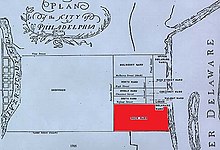
Society Hill was initially known as the Dock Ward, an appropriate designation until the post-World War II period when the shipping industry declined and relocated. The Dock Ward, first defined in 1705, was one of the ten original wards that the city used to subdivide land east of 7th Street. As part of the 1854 Act of Consolidation, the Dock Ward was renamed the 5th Ward. The wards were realigned in 1965 and the boundaries of the 5th Ward no longer correspond to Society Hill's boundaries.
Geography
The land area of Society Hill is approximately 0.254 square miles (163 acres). Bordering the Delaware River just south of Old City and Independence Hall, Society Hill is loosely defined as bounded by Walnut, Lombard, Front and 8th Streets. The Society Hill Civic Association further subdivides Society Hill along Spruce Street and 4th Street into quadrants by intercardinal directions: northeast (NE), southeast (SE), southwest (SW), and northwest (NW). Across different sources, variation in the exact border includes extending the eastern boundary to the Delaware River, the southern border to South Street, the northern border to Chestnut Street, or limiting the western border to 7th Street.
History
See also: History of Philadelphia
With prime access to the Delaware River and Philadelphia's civic buildings, including Independence Hall, the neighborhood quickly became one of the most populous areas in colonial Philadelphia. Several market halls, taverns and churches were built alongside brick houses of Philadelphia's affluent citizens.
After the Revolutionary War, the polluted Dock Creek—which had been used as a public sewer—became Dock Street when the city filled in the creek and created a new food distribution market. Though the streets of Philadelphia were carefully laid out in a grid, the new Dock Street's arc connecting Chestnut and Spruce Streets between 2nd and 3rd, owes its uncharacteristic shape to the path of the former creek as it ran to the river.
In the 19th century, the city expanded westward and the area lost its appeal. Houses deteriorated, and by the 1940s, Society Hill had become a slum neighborhood, one of the worst in the city.
In the 1950s, the city, state and federal governments began one of the first urban renewal programs aimed at the preservation of historic buildings. While most commercial 19th-century buildings were demolished, historically-significant houses were restored by occupants or taken over by the Philadelphia Redevelopment Authority and sold to individuals who agreed to restore the exteriors. Replicas of 18th-century street lights and brick sidewalks were added to enhance the colonial atmosphere. Empty lots and demolished buildings were replaced with parks, walkways, and modern townhouses.
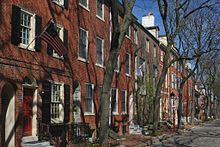
From 1957–1959, the Greater Philadelphia Movement, the Redevelopment Authority and the Old Philadelphia Development Corporation bought 31 acres (130,000 m) around Dock Street. They demolished and relocated the Dock Street market, setting aside 5 acres (20,000 m) of land that would become the Society Hill Towers. In 1957, Edmund Bacon, the executive director of the Philadelphia City Planning Commission, awarded developer-architect firm Webb and Knapp the competition for the redevelopment of Society Hill. Architect I. M. Pei and his team designed a plan for three 31-story Society Hill Towers and low-rise buildings. The Towers and townhouses project was completed in 1964, while the entire plan was completed in 1977. Architect Louis Sauer designed dozens of rowhouse projects for the area around Society Hill, including Waverly Court and Penn's Landing Square.
Historic buildings in Society Hill include the Society Hill Synagogue, built in 1829 as a Baptist church by Philadelphia architect Thomas Ustick Walter, one of the architects of the United States Capitol in Washington, D.C. The synagogue was entered into the National Register of Historic Places in 1971. Another notable building is St. Peter's Church, constructed between 1758 and 1761 by Robert Smith. Congregation Kesher Israel occupies and has renovated the building constructed by the Universalist Church in 1796 at 412 Lombard Street.
The Society Hill Historic District was listed on the National Register of Historic Places in 1971. In 1999, it was listed on the Philadelphia Register of Historic Places.
Demographics
See also: Demographics of Philadelphia| Year | Pop. | ±% |
|---|---|---|
| 1860 | 24,792 | — |
| 1950 | 7,000 | −71.8% |
| 1970 | 4,841 | −30.8% |
| 1980 | 5,213 | +7.7% |
| 1990 | 5,715 | +9.6% |
| 2000 | 5,808 | +1.6% |
| 2010 | 6,215 | +7.0% |
| Source: Encyclopedia of Greater Philadelphia for 1860 and 1950 populations. Center City District for populations from 1970-2010. | ||
As of the 2010 United States Census, there were 6,215 people residing in Society Hill, which accounts for 0.4% of Philadelphia's total population. With 22,281 people per square mile, Society Hill's population density is about twice that of Philadelphia's 11,497 people per square mile.
Education
Primary and secondary schools
Residents of all neighborhoods in Philadelphia are assigned to specific public schools by the School District of Philadelphia. Society Hill residents are zoned to the General George A. McCall School, located at 325 S. 7th Street, for kindergarten through eighth grade, and all persons zoned to McCall are assigned to Benjamin Franklin High School. Previously Furness High School was the zoned high school for Society Hill.

The McCall School serves Society Hill and the Chinatown areas. A construction contract for the McCall school building was awarded on October 26, 1909 and the official opening occurred in February 1911. Russell Scott Smith of Edutopia wrote that in 2004, compared with other schools in Philadelphia, "McCall already had a fairly good reputation for academic rigor and safety" and that by 2009 it had improved even more. In 2012 Kristen A. Graham of The Philadelphia Inquirer stated that McCall was one of "the district's stronger neighborhood schools".
St. Peter's School, located on Lombard Street between 3rd and 4th, is an independent, coeducational, non-sectarian day school, serving students in preschool (age 3) through eighth grade. The school was founded in 1834.
The designated parochial grade school of Old St. Mary's Church and Old St. Joseph's Church, of the Roman Catholic Archdiocese of Philadelphia, is St. Mary Interparochial Grade School.
Libraries
The Free Library of Philadelphia operates the Independence Branch at 18 South 7th Street. The Athenaem is a private library and museum with collections including architecture and interior design history, particularly for the period from 1800 to 1945.
Historic congregations
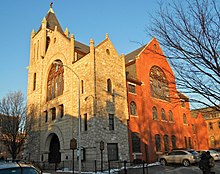
Society Hill's many historically significant congregations reflect the fruition of William Penn's Quaker maxim of religious toleration.
- Old St. Joseph's Church (1733)
- St. Peter's Church (1761)
- Old St. Mary's Church (1763)
- Old Pine Street Church (1768)
- Holy Trinity Church (1784)
- Mother Bethel A.M.E. Church (1794)
- Society Hill Synagogue (since 1967; First Baptist from 1829–1909; Roumanian-American Hebrew Congregation from 1910-1966)
Transportation
Further information: Transportation in PhiladelphiaSociety Hill is accessible via several forms of public transportation.
Rapid Transit
Historic siteThe Market–Frankford subway line stops at 2nd Street and 5th Street, which are two blocks north of Society Hill's Walnut Street boundary.
The PATCO Speedline, a rapid transit system connecting Philadelphia and southern New Jersey stops at 8th and Market Street station, two blocks north of Society Hill, and at the 9th and Locust Street station, which is one block west of Society Hill's 8th Street boundary.
Bus
The SEPTA 9 and 21 buses run westbound along Walnut Street. The 12 and 42 run westbound along parts of Spruce and Walnut Streets. The 12 also runs eastbound along Pine Street. The 47 runs northbound along 7th Street and southbound along 8th Street. The 57 runs northbound along 3rd Street and southbound along 4th Street.
Bikeshare
Since 2009, as part of a crosstown buffered bike lane pilot project, bike lanes were installed that run eastbound along Pine Street and westbound along Spruce Street. Society Hill is served by Indego bike-share stations at 9th and Locust Streets, 4th and Walnut Streets, Dock and Front Streets, 2nd and Lombard Streets, and 6th and Locust Streets.
Greenways
Society Hill contains pathways that connect the residential neighborhood with historic areas to the north. These paths are known as greenways and were designed specifically for pedestrian travel to minimize interaction with automobile traffic. The landscaped greenways were conceived by Edmund Bacon, who hired John Collins of Adleman, Collins & DuTot to design small-scale greenway parks and pedestrian connections woven mid-block between buildings. St. Joseph's Way, St. Peter's Way, and Lawrence Court Walk are greenways that connect community places including St. Peter's, Old Pine, Three Bears Park, and Bingham Court. The greenways feature public art and are designed to create a neighborhood that is walkable, rather than a disjointed collection of historic buildings.
Notable people
Society Hill has long been a popular neighborhood for numerous notable people. Past and present notable residents include:
- Lynne Abraham (b. 1941)
- Richard Allen (1760-1831)
- Baruch Samuel Blumberg (nobel prize winner) (1925-2011)
- Richardson Dilworth (1898-1974)
- Terry Gross (b. 1951)
- Alexander Hamilton (1757-1804)
- Thaddeus Kosciuszko (1746-1817)
- James Madison (1751-1836) and Dolley Madison (1768-1849)
- John Penn (1729-1795)
- Philip Syng Physick (1768-1837)
- Samuel Powel (1738-1793)
- Wendell Pritchett
- Thomas Sully (1783-1872)
- Chase Utley (b. 1978), longtime major league baseball player
Points of interest

Some of the most notable points of interest within Society Hill are listed below and marked on the adjacent map.
- The St. James 700 Walnut St.
- Tomb of the Unknown Revolutionary War Soldier – Washington Square
- Athenaeum of Philadelphia 219 S. 6th St.
- Contributionship 212 S. 4th St.
- Old St. Joseph's Church 321 Willings Alley
- Powel House 244 S. 3rd St.
- Society Hill Towers 200 Locust St.
- Korean War Memorial 109 Spruce St.
- Sully Residence 530 Spruce St.
- Society Hill Synagogue 418 Spruce St.
- St. Mary's Roman Catholic Church 252 S. Fourth St.
- Physick House 321 S. 4th St.
- Cassey House 243 Delancey St.
- Mother Bethel A.M.E. Church 419 S. 6th St.
- Cong. B'nai Abraham 523 Lombard St.
- Vilna Congregation 509 Pine St.
- Old Pine Street Church 412 Pine St.
- St. Peter's School 319 Lombard St.
- St. Peter's Episcopal Church 3rd and Pine St.
- Kosciuszko House 301 Pine St.
- Head House 400 block of S. 2nd St.
Points of interest just north of Society Hill are the Liberty Bell, Independence Hall, Carpenters' Hall, the First Bank of the United States, the Second Bank of the United States, the Merchants' Exchange Building, and the Museum of the American Revolution.
See also: National Register of Historic Places listings in Center City, PhiladelphiaFilm appearances
- In National Treasure (2004), Nicolas Cage's character runs through the streets of Society Hill, the graveyard of Old Pine Street Church and Headhouse Market.
- The Sixth Sense (1999)
Gallery
-
St. Peter's Church
-
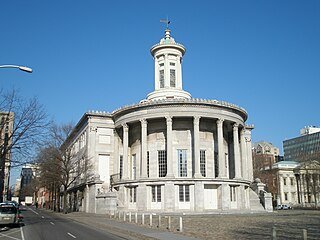 Merchants' Exchange Building
Merchants' Exchange Building
-
Townhouses by Washington Square
-
 Old Pine Street Church
Old Pine Street Church
-
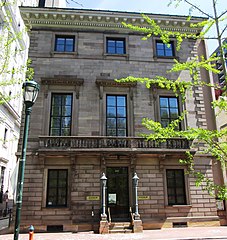 Athenaeum
Athenaeum
See also
- Bathsheba's spring and bower
- Benjamin Loxley house
- Cassey House
- Independence National Historical Park
- National Register of Historic Places listings in Center City, Philadelphia
- Philadelphia Korean War Memorial
Notes
- The Philadelphia Register of Historic Places (PRHP) set its proposed boundaries for the Society Hill historic district to include five adjacent groups of buildings. See the PRHP map reference and page 6 of the nomination document. The National Register of Historic Places boundaries include the area between Front St. and the Delaware River.
- Though the Merchants' Exchange Building is located on the north side of Walnut St. and could also be considered part of the Old City neighborhood, buildings on both sides of Walnut are included in the National Register of Historic Places boundaries for the Society Hill historic district.
References
- "National Register Information System". National Register of Historic Places. National Park Service. March 13, 2009.
- ^ "Society Hill (and Pennsylvania Hospital of Washington Square West) Historic District" (PDF), phila.gov, Philadelphia Historical Commission, City of Philadelphia, p. 1, archived from the original (PDF) on November 1, 2016, retrieved December 14, 2016,
Note: PDF file link found on phila.gov/historical/register/Pages/districts.aspx
- ^ "Philadelphia Register of Historic Places - Society Hill Nomination" (PDF). phila.gov. Philadelphia Historical Commission, City of Philadelphia. March 10, 1999. pp. 1–2. Archived (PDF) from the original on November 1, 2016. Retrieved December 14, 2016.
Note: PDF file link found on phila.gov/historical/register/Pages/districts.aspx
- ^ "National Register of Historic Places Inventory - Nomination Form". nps.gov. National Park Service. June 23, 1971. p. 5. Archived from the original on December 21, 2016. Retrieved December 20, 2016.
- ^ "Society Hill neighborhood". city-data.org. Retrieved December 25, 2016.
- ^ "Philadelphia Register of Historic Places: List of historic districts". phila.gov. Philadelphia Historical Commission. Archived from the original on November 1, 2016. Retrieved December 14, 2016.
- "Leading the Way: Population Growth Downtown" (PDF). centercityphila.org. p. 4. Retrieved December 22, 2016.
- The Center City District dates the Free Society of Traders to 1683. See "Neighborhood: Society Hill". centercityphila.org. Retrieved December 22, 2016. Other sources show that the Society was established in 1681. See Lance R. Eisenhower. "Free Society of Traders". philadelphiaencyclopedia.org. Retrieved December 30, 2016. William Penn did not arrive until October 1682. See History of Philadelphia.
- ^ Orso, Anna (18 March 2015), Society Hill: Philly's richest ZIP code, where The Sixth Sense was filmed and Chase Utley lives, BillyPenn.com, retrieved December 30, 2016
- As of 2013, the median household income in Society Hill was $93,222, and the average income was $145,260, which are the highest values for any neighborhood in Philadelphia. "Philadelphia 2013: The State of the City" (PDF). pewtrusts.org. Retrieved December 22, 2016.
- ^ Great Places in America -- Society Hill: Philadelphia, Pennsylvania, American Planning Association, 2008, retrieved December 30, 2016
- ^ Dowdall, George W. (2015), Society Hill, The Encyclopedia of Greater Philadelphia, retrieved December 30, 2016
- FRANKLIN STREET LAMPS, Philadelphia, Forgotten New York, May 16, 2015, retrieved December 30, 2016
- ^ "Free Society of Traders". philadelphiaencyclopedia.org/. Retrieved December 25, 2016.
- Gottlieb, Dylan (2014), Gentrification, The Encyclopedia of Greater Philadelphia, retrieved January 2, 2017
- City Political Subdivisions 1705-1854, City of Philadelphia, retrieved January 2, 2017
- ^ City Political Subdivisions 1854-1965, City of Philadelphia, retrieved January 2, 2017
- Society Hill Map, Society Hill Civic Association, retrieved January 6, 2017. See also SHCA Block Coordinators, Society Hill Civic Association, retrieved January 6, 2017.
- The Society Hill Civic Association includes the area east of Front Street as part of Society Hill and recognizes residents of the 300 and 400 blocks of Gaskill Street and the 500 block of Front Street (all south of Lombard) as part of Society Hill. Society Hill Map, Society Hill Civic Association, retrieved January 6, 2017; See also SHCA Block Coordinators, Society Hill Civic Association, retrieved January 6, 2017. The inclusion of these few blocks below Lombard Street is consistent with the southern boundaries that designate which buildings are within the Society Hill Historic District, as opposed to the neighborhood of Society Hill.
- Google Maps indicates that the southern border of Society Hill extends one block past Lombard street to South Street and that the western boundary terminates at 7th Street instead of 8th. Society Hill, Philadelphia, Google Maps, retrieved January 6, 2017
- The Center City District has adopted the Google boundaries, but extended the northern border by one block to Chestnut Street.Neighborhood: Society Hill, Center City District, retrieved January 6, 2017
- Perrine, William (January 27, 1919). "Dock Street". Evening Bulletin. Philadelphia. Retrieved 2016-01-21.
- Gallery, John Andrew, ed. (2004), Philadelphia Architecture: A Guide to the City (2nd ed.), Philadelphia: Foundation for Architecture, ISBN 0962290815, p.119
- Le Faivre-Rochester, Carole (2003), "Society Hill Towers: A Bold and Graceful Venture", in Herman Baron (ed.), I.M. Pei and Society Hill: A 40th Anniversary Celebration, DIANE Publishing Co., p. 35, ISBN 9780756735548, retrieved December 31, 2016
- Perkins, Dorothy (2003), "Society Hill Towers: A Bold and Graceful Venture", in Herman Baron (ed.), Biography of I.M. Pei, DIANE Publishing Co., p. 8, ISBN 9780756735548, retrieved December 31, 2016
- Le Faivre-Rochester, p. 36.
- George W. Dowdall. "Society Hill". philadelphiaencyclopedia.org. Retrieved December 30, 2016.
- "Center City Developments" (PDF). centercityphila.org. p. 4. Retrieved December 20, 2016.
- "Leading the Way: Population Growth Downtown" (PDF). centercityphila.org. p. 4. Retrieved December 22, 2016.
- Jackson, Leigh. "SCHOOL BOARD TACK: SLASH, UNSLASH" (Archive). Philadelphia Daily News. May 28, 1994. 06 Local. Retrieved on November 8, 2011. - Article info
- "Gen. George A. McCall Elementary School Geographic Boundaries" (Archive). School District of Philadelphia. Retrieved on November 28, 2015.
- "High School Directory Fall 2017 Admissions" (Archive). School District of Philadelphia. p. 30/70. Retrieved on November 16, 2016.
- "Horace Furness High School Geographic Boundaries" (Archive). School District of Philadelphia. Retrieved on November 28, 2015.
- Kadaba, Lini S. "An Effort To Speak To More Students The School District Is Extending The Reach Of Its Bilingual Programs." (Archive). The Philadelphia Inquirer. October 6, 1998. Article info. B01 City & Region. Retrieved on November 29, 2015.
- "A Little Bit of History" (Archive). McCall Home and School Association. Retrieved on November 28, 2015.
- Smith, Russell Scott. "Affluent Parents Return to Inner-City Schools for Educational Opportunities" (Archive). Edutopia. August 26, 2009. Retrieved on November 28, 2015.
- Graham, Kristen A. "Organizers raise funds to offer free summer school" (Archive). The Philadelphia Inquirer. July 12, 2012. Retrieved on November 28, 2015.
- St. Peter's School, At A Glance
- "OLD St. JOSEPH'S". Roman Catholic Archdiocese of Philadelphia. 2002-06-12. Archived from the original on 2002-06-12. Retrieved 2020-04-22.
- "Old St. Mary's". Roman Catholic Archdiocese of Philadelphia. 2001-11-02. Archived from the original on 2001-11-02. Retrieved 2020-04-22.
- "Independence Branch." Free Library of Philadelphia. Retrieved on January 20, 2009.
- The Athenaeum of Philadelphia, Mission and History
- Low, Setha; Taplin, Dana; Scheld, Suzanne (May 21, 2009). Rethinking Urban Parks: Public Space and Cultural Diversity. Austin, Texas: University of Texas Press. p. 168. ISBN 978-0292778214. Retrieved December 29, 2016.
- SEPTA 9 (4th-Walnut to Andorra) (PDF), Southeastern Pennsylvania Transportation Authority, September 4, 2016, retrieved December 30, 2016
- ^ SEPTA 12 (Columbus-Dock to 50th-Woodland) (PDF), Southeastern Pennsylvania Transportation Authority, September 4, 2016, retrieved December 30, 2016
- SEPTA 42 (Penn's Landing to Wycombe or 61st-Pine) (PDF), Southeastern Pennsylvania Transportation Authority, September 4, 2016, retrieved December 30, 2016
- SEPTA 47 (Whitman Plaza to 5th-Godfrey) (PDF), Southeastern Pennsylvania Transportation Authority, September 4, 2016, retrieved December 30, 2016
- SEPTA 57 (Whitman Plaza to Rising Sun-Olney or Fern Rock Transportation Center) (PDF), Southeastern Pennsylvania Transportation Authority, September 4, 2016, retrieved December 30, 2016
- Case Study: Buffered Bike Lanes on Pine and Spruce Streets, Philadelphia, PA, National Association of City Transportation Officials, 18 February 2011, retrieved December 30, 2016
- Station Map, Indego, retrieved July 8, 2021
- ^ Heller, Gregory L. (2013). Ed Bacon: Planning, Politics, and the Building of Modern Philadelphia. Philadelphia: University of Pennsylvania Press. p. 120. ISBN 9780812207842.
- "Society Hill". The Cultural Landscape Foundation. Retrieved 22 October 2017.
- Hahn, Ashley (14 August 2012). "Eyes on the Street -- Love Note #45: Walk Ed Bacon's greenways with me". PlanPhilly. Retrieved 22 October 2017.
- "Sunday Morning Bacon: Society Hill's Greenways". Jane's Walk. 2014. Retrieved 22 October 2017.
- Alan Jaffe (April 12, 2012). "Update: Commonwealth Court upholds Dilworth House appeal". whyy.org. PlanPhilly/WHYY. Retrieved October 8, 2019.
- "Alexander Hamilton in Philadelphia". The Constitutional Walking Tour. 30 November 2016. Retrieved December 18, 2019.
- "Thaddeus Kosciuszko". National Park Service. Retrieved December 30, 2016.
- Romero, Melissa (May 9, 2016). "James and Dolley Madison House in Society Hill Lists for $3.2M". Curbed Philadelphia. Retrieved December 30, 2016.
- "Physick House". philalandmarks.org. Philadelphia Society for the Preservation of Landmarks. Retrieved October 8, 2019.
- "Powel House". philalandmarks.org. Philadelphia Society for the Preservation of Landmarks. Retrieved October 8, 2019.
- Hetrick, Christian; Silverman, Ellie (April 6, 2019). "Wendell Pritchett, 87, Philadelphia music teacher". The Philadelphia Inquirer. Retrieved October 8, 2019.
Son Wendell became Penn's first African American provost in 2017.
- Leitereg, Neal J. (October 2, 2014). "Phillies' Chase Utley lists Philadelphia penthouse for rent". The Los Angeles Times. Retrieved December 30, 2016.
- Jennings, James (December 9, 2014), The Ultimate National Treasure Filming Map of America, Curbed Philadelphia, retrieved December 30, 2016
External links
- Society Hill Civic Association
- Society Hill Playhouse
- General George A. McCall School
- Historic Photographs of Philadelphia, at PhillyHistory.org
| Places adjacent to Society Hill | ||||||||||||||||
|---|---|---|---|---|---|---|---|---|---|---|---|---|---|---|---|---|
| ||||||||||||||||
| Society Hill | |||||||
|---|---|---|---|---|---|---|---|
| Northwest Quadrant |
| ||||||
| Northeast Quadrant |
| ||||||
| Southwest Quadrant |
| ||||||
| Southeast Quadrant |
| ||||||
| Quadrants are divided along Fourth and Spruce streets. This list is incomplete. | |||||||
| US National Register of Historic Places in Pennsylvania | ||
|---|---|---|
| Topics |   | |
| Lists by county |
| |
| Lists by city | ||
| Other lists | ||
